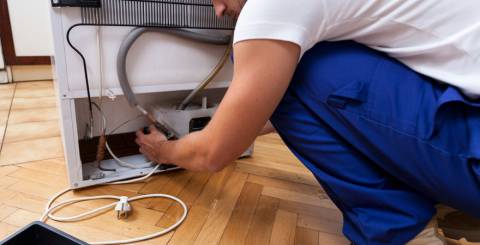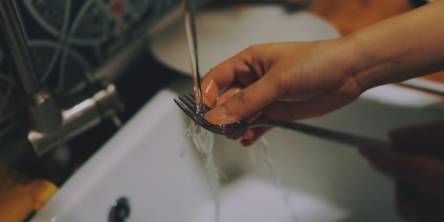3 Ways to Fix Refrigerator Leaking Water

Fridges are probably the most important household appliances modern homes can’t be imagined without. They’re also quite expensive and not as easy to maintain as most people think. The improper use, the lack of the regular cleanings, the excessive workload, the outside conditions the fridge has to operate in and common minor functioning failures that aren’t treated on time may lead to significant breakdowns and, consequently, repairing or replacing costs.
As it’s not only a clogged kitchen sink or a broken dishwasher that may flood your kitchen, but also the fridge’s faulty operation that makes it leak, it’s quite important to be proactive and prevent refrigerator water leaks by cleaning your appliances regularly and defrosting even the frost free or frost control fridges to avoid faulty water lines and sudden leaks.
But, if those actually happen, you need to take immediate actions to determine the culprit of the leak and figure out the way to stop it. To do that, you need to learn what may make your refrigerator leak, which parts of the appliance you need to examine to figure out where the water comes from, and how to fix the issue.
So, here’re top 3 reasons why your refrigerator may leak and which steps have to be taken to bring your fridge back to order in each of those cases.
1. The defrost drain is blocked
What happens
When you notice a leak in your fridge, the defrost drain is the first place you need to check. When tiny food crumbs and other small particles accumulate in that drain, they may clog its hose, cause the buildup of the ice that prevents the water condensate and other excessive moisture from draining and your refrigerator from being able to control the frost or defrost on its own depending on the model of your appliance.
Eventually, it will leak. The more time you take to fix the issue, the more water your fridge will leak and the more probable the major breakdown will get.

How to fix
The solution is quite obvious and doesn’t require any advanced skills or knowledge to apply. You just need to unplug your refrigerator, find the defrost drain’s opening at the back wall of the fridge (not the freezer), use a small kitchen funnel or a kettle to run hot water through the drain and relieve it from the ice blockage.
After that, you’ll have to clean out the debris that was the main cause of the problem. Thus, grab a thin drain cleaning snake to get rid of the clog. If you don’t have one, you may easily use a long wire or a straightened metal hanger instead. Clean both from the inside and the back of the fridge.
But, if you don’t have the pipe snake or if you just can’t locate the blockage, don’t leave the drain issue not handled and ask a plumber or an appliance repair pro to finish the task. Otherwise, you’ll have to deal with frequent leaks and fridge malfunctions.
2. Misaligned water filter
What happens
When the water filter wasn’t installed properly and it’s misaligned in its housing, it might leak water. In addition to that, the water might leak from the water filter compartment of the fridge if the filter’s housing is broken or cracked. Broken filters cause leaks as well.

How to fix
Unplug the fridge, undo the filter and reinstall it, making sure that the filter and its housing are properly aligned. If that doesn’t do the job, get your fridge inspected and its filter/filter’s housing replaced.
3. Water leaking from under the fridge – frozen or broken water supply line
What happens
This often happens to the models with the built-in cold water and ice makers. The reason for this problem is quite similar to the previous one – the debris clog or the ice buildup that interrupts the water line’s normal flow makes the water leak and influences the ice and cold water production.

How to fix
The first thing to do is to unplug the appliance, find the shut-off valve that is related to the refrigerator’s water line (it may be located behind the fridge, under the kitchen sink or in the basement right underneath the fridge).
Then, you’ll have to inspect plastic pipes to determine if there’re any frozen water clogs in them. If you notice any, you’ll just need to leave your refrigerator to defrost for a few hours and test the fridge. If the ice clog was the ultimate culprit of the leak, the fridge should be alright after it’s all melted and gone. Finally, check the drain pan for any damages just in case.
However, if it’s not the ice that clogged the water line or if there’re any cracks in the actual pipes, you’ll have to consult with an expert or even get them cleaned/replaced by an appliance repair pro not to damage the system.
Similar Articles
When household appliances break down, the immediate reaction is often frustration. Attempting a do-it-yourself fix might seem like the quickest and most cost-effective solution. However, these attempts can lead to further damage, increased costs, and even safety hazards without the proper knowledge and precautions.
Learn how to maintain your dishwasher for optimal performance, energy efficiency, and a longer lifespan with these simple tips and expert advice.
When searching for appliances, consumers often look for the best deals that deliver quality without overextending their budget. One of the most practical solutions is to consider factory seconds, appliances that, due to minor cosmetic flaws or packaging damages, are sold at significantly reduced prices.
A Makita oscillating tool is a flexible device for precise and neat cutting. Whether you are cutting wood, plastic, or metal, this tool streamlines your job. Still, how would you apply exact incision techniques?
The significance of clean and pure water cannot be overstated when it comes to maintaining optimal health and wellness. With growing concerns over contaminants and pollutants found in tap water, the demand for effective water purification solutions is at an all-time high.
Discover 5 appliances designed for low-maintenance living, keeping your home running smoothly without constant upkeep.
When it comes to enjoying a good steak, the right tools can elevate the experience, and that includes the often-overlooked steak knife. A high-quality steak knife isn’t just another piece of cutlery; it’s specifically designed to make each cut effortless, enhancing the flavor and texture of the meat
Are you a lawn enthusiast who revels in the sights and sounds of perfectly manicured hedges? Maybe you're an avid DIYer who enjoys turning a pile of lumber into an eye-catching piece of furniture? Or perhaps the thought of having your own cordless chainsaw brings out your inner lumberjack?
Discover effective solutions for common issues with under sink water coolers. Our troubleshooting guide ensures your water cooler runs smoothly.









